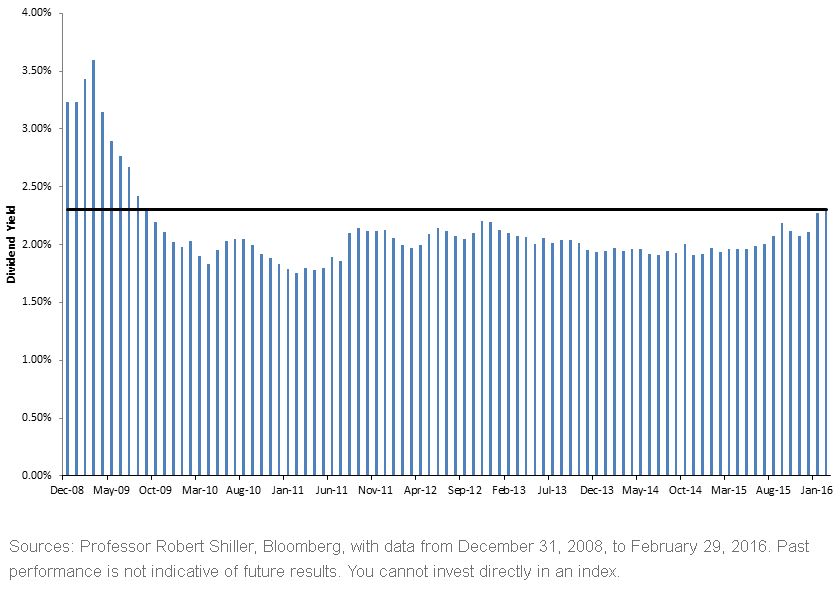
Global Chief Investment Officer
Follow Jeremy Schwartz
One of the market’s major anxieties has been that the gains we’ve experienced since the financial crisis were mostly artificially induced by
monetary easing from central banks and that now, with the Federal Reserve (Fed) starting to raise
interest rates, we are likely to see more
volatility and pressures on the market.
The volatility certainly has come, but the market gains were, in fact, supported by underlying positive trends in one of the most important
fundamental metrics of the markets we track: the cash
dividends companies are paying to their shareholders.
The
dividend yield is one
valuation gauge for the market. At nearly 2.3%, as the
S&P 500 Index was priced on February 29, 2016, this represents a level that had not been reached on a monthly basis going back as far as September 2009.
1 Back then, the S&P 500 had an index level just slightly above 1,000.
At the end of February, the S&P 500 stood at 1,932, some 90% higher than in 2009. The fact that the dividend yield was at the same level means that
aggregate dividends also rose approximately 90% over the period—or more than 10% per year.
2
This shows that the gains in the market were not being artificially driven by Fed easing. Since September 2009, the market gains have been broadly in line with the
dividend growth of the market.
While earnings deteriorated in aggregate in 2015, the
median dividend growth for S&P 500 companies was still approximately 10%. While double-digit rates are unlikely to continue indefinitely, we can potentially see
per share growth rates of 7%–8% continue. This is our expectation for dividend growth on the market over the next five years and longer.
When we focus on the dividend yield of 2.3% as a valuation guide, some investors quip that one can easily lose that dividend percentage in a single day with the market volatility—and that is, of course, true.
But the dividend yield and, importantly, the dividend growth of the market is what we believe will drive long-term returns. Just like this
market was powered over the last six years by rising dividend trends, we see the underlying dividend trends and health as supportive for continued allocations to equities over the other competing asset classes.
The
10-year U.S. government bond yield today is just 1.73%,
3 which implies an extremely low level of income potential for investors over the next 10 years. When we hear growing calls that this was just a Fed-induced rally, we go back to these dividend trends: they were absolutely a key fundamental driver, and it’s clear the market has not gotten more expensive against this key fundamental metric since September 2009.
2/29/16 Dividend Yields Revert to 09/30/09 Levels with S&P 500 Rising ~90% Over the Period
 1
1Sources: Professor Robert Shiller, Bloomberg, as of 2/29/16.
2Sources: Professor Robert Shiller, Bloomberg, with period from 9/30/09 to 2/29/16.
3Source: Bloomberg, with data as of 2/29/16.
Important Risks Related to this Article
Dividends are not guaranteed, and a company currently paying dividends may cease paying dividends at any time.


 1Sources: Professor Robert Shiller, Bloomberg, as of 2/29/16.
2Sources: Professor Robert Shiller, Bloomberg, with period from 9/30/09 to 2/29/16.
3Source: Bloomberg, with data as of 2/29/16.
1Sources: Professor Robert Shiller, Bloomberg, as of 2/29/16.
2Sources: Professor Robert Shiller, Bloomberg, with period from 9/30/09 to 2/29/16.
3Source: Bloomberg, with data as of 2/29/16.


